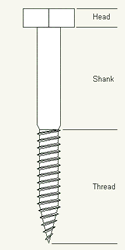
Figure 1 - Lag Bolt Parts
Nothing is more frustrating than screwing in a lag bolt and having the shaft snap in two as you apply torque to the head, usually at the point where the thread meets the shank. Because of this, it is generally wise to use pilot holes pre-drilled in the wood.
The size of the pilot holes is somewhat dependent on the species of lumber and its age and because of that, some experimentation with the correct pilot holes for your project might be undertaken.
However, there is a rule of thumb that can be used. The pilot hole for the shank should be the same as the diameter of the bolt and the pilot hole for the threaded portion should be 3/4 of the diameter for softwoods and slightly larger for larger diameter bolts used in hardwoods as shown in Table 1.
| Table 1 - Pilot Hole Sizes For Lag Bolts | |||
| Bolt Size | Shank Pilot Hole | Threaded Pilot Hole | |
| Softwood | Hardwood | ||
1/4" |
1/4" |
3/16" |
7/32" |
5/16" |
5/16" |
15/64" |
1/4" |
3/8" |
3/8" |
9/32" |
5/16" |
1/2" |
1/2" |
3/8" |
7/16" |
Some reference books will suggest the use of soap on the end of the threaded portion of the lag bolt in order to provide some lubrication to the threads. This is definitely not a good idea, as soap will cause a steel lag bolt to rust prematurely, although it will have no effect on stainless steel or galvanized lag bolts.
If you would like to use a lubricant, bees wax is the best choice. If you do not have bees wax readily available, use some vegetable oil.
Lag bolts are more likely to break if driven in on an angle.
